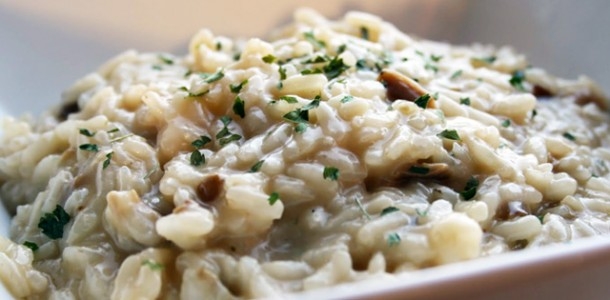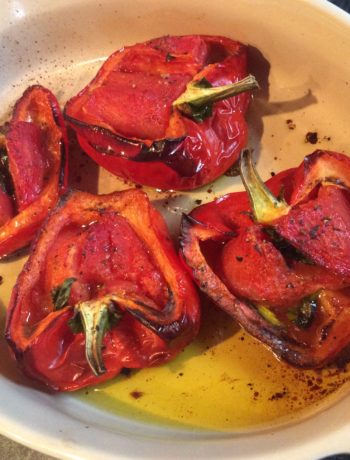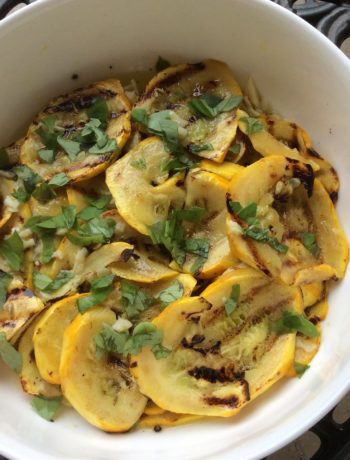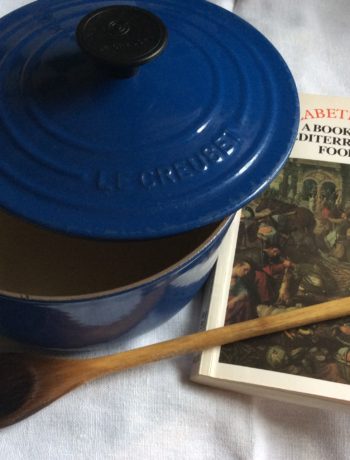It is my observation that in Italy people do cook more from scratch, in all income brackets and across all the age groups. And EVERYONE can make a risotto (or at least everyone I know)! I know that some people regard it as a bit of a monster, but honestly, it isn’t. It is a really useful basic technique to have and I was very lucky to have been taught by a Milanese lady, in Milan, in the 90’s. So to my mind, I have been taught in the best possible way and have been given an understanding of and feeling for the ingredients that I’m not entirely sure you can get from books – or blogs! Making risotto is not something that is the same every time you do it and you need to develop (literally) a feeling for the way the rice is behaving in the pan: how heavy it feels, how it smells, tastes and even sounds. Unless you have a gifted donna Milanese to hand, the only way is practice, practice, practice.
Rice production is big business in northern Italy, the cultivation dating back as far as I can tell from my research, to about 1475 when Galeazzo Maria Sforza, Duke of Milan claimed that one sack of rice, properly cultivated, could yield another twelve sacks. He certainly promoted the cultivation of rice (and indeed the commercialisation of silk and wool weaving, although in most other respects, he seems to have been a bad hat), going so far as to sponsor the construction of canals for irrigation. There is evidence that the Romans knew of it as a costly import from India, the grain being reserved to make a dish served to those suffering digestive ills or to the very rich. By all accounts it sounds rather like our present day British rice pudding.
The industrialisation of rice production was hugely aided by the construction between 1863 and 1866 of the Cavour Canal. This takes water from Italy’s longest river, the magnificent Po, starting at Chivasso, north east of Turin and ending at Galliate, north west of Milan and all within the region of Piedmont. These days, rice harvesting is mechanised using what look to my untutored eye like combine harvesters and doesn’t look in the slightest like the scenes from “Bitter Rice”. In the past – in fact up until the 60’s – rice was harvested by hand by teams of women who would invade the rural rice growing areas to spend their days barefoot in water, bent double harvesting the grains by hand. They would be accommodated in fairly spartan barn-type buildings, which these days are being gentrified into designer homes. I do know of one remaining “dormitory” which having been abandoned, is now occupied only by wildlife. Edoardo and I are going to re-visit it shortly, as like a fool, I didn’t take any photographs when I was last there. I will post when I’ve revisited – just hope it is still there and hasn’t been swathed in scaffolding for rebuilding – not yet anyway.
So, to the recipe itself and I’ll talk a little about ingredients first.
You start with selecting the correct rice. Most important and I have been party to some spirited debates in Italy about which rice is used for which risotto! There are three grades of rice: semifino, the smallest grain; fino and superfino, which has the largest grain. Within each of those, there three varieties:
Arborio which makes a dense, sticky risotto, perhaps a tad stodgy but also tends to be the cheapest of the three and honestly, it makes a perfectly acceptable risotto for most occasions
Vialone nano has a round, thick grain (a bit like our pudding rice) and can take quite a lot of rough and tumble before it breaks (broken rice in a risotto can be a sign of poor technique) and is very absorbent. I use it with big, hearty ingredients
Carnaroli is my personal favourite with long, slender grains that can absorb enough liquid to be creamy but never go stodgy. If you are making a risotto with premium ingredients such as asparagus, saffron or seafood, I’d always recommend this rice as it is a little more elegant than say, arborio.
My favoured brands are Acquarello and Curtiriso, the latter partly because not only is it is good rice but also because their production process is carbon neutral. I usually bring both brands back from Italy but Curtiriso can also be found in the UK on-line at www.nifeislife.com If you can’t get either of these, use what you can get but please make sure it is rice actually grown in Italy – don’t be deceived by an Italian looking label!
You will also need onion or shallot. I prefer shallot, especially if I am making a seafood, saffron or asparagus risotto, as it has a more subtle presence. If you only have onion, don’t fret, just ensure you chop it finely so it renders down quite easily. You don’t want to see pieces of shallot or onion in the finished dish. Sometimes I use a stick of celery as well, but optional.
Stock is a subject that seems to send otherwise sane, pleasant people to borders of insanity. Yes, life would be wonderful if one had a permanent supply of freshly made vegetable/chicken/veal stock on hand and sometimes I do have it. I do know of someone who declaims that “no Italian would make risotto from a cube so I don’t”. Huh, this from someone who has never been inside an Italian’s kitchen, speaks no Italian and – here’s the paradox – buys ready grated Parmesan. Don’t let absence of fresh stock deter you from making a risotto, but do choose your cube or powder with care. I can recommend Kollo, Marigold and an Italian brand called Star. The latter do a porcini flavoured cube which is excellent for an autumnal risotto al funghi and if you’re in Italy, they are in every supermarket and take up no room at all to bring home.
Cheese – ah, now this is probably where I become borderline insane. Ready grated Parmesan is not worth spending money on. There, I’ve said it, but honestly, I can find nothing good to say about it. Please, please if you only do one thing to upgrade your risotto, buy your Parmesan or Grana Padano in a biggish piece, preferably 18 – 30 months old. You don’t need fancy-smancy graters, either. I just use a normal three sided grater (of venerable age, I might add) and I use different sized grating faces, depending on whether the cheese is going in or on the risotto. I am writing extensively elsewhere about the virtues of Parmesan and its history so will leave it there for now.
Alcohol. It is nice to slosh some white wine into a risotto but in fact, I use Martini Extra Dry more often as we don’t drink that much white wine. And talking of which, what has Martini done with those fabulous fin de siècle bottle labels? This new minimalist label looks a bit “supermarket own brand” to me. Anyway, again, if you don’t have anything, don’t let this deter you from a risotto.
Butter. Possibly another of my rants coming on here, but I’ll try to contain myself. The final step in making a risotto is the mantecatura. This is resting the risotto and adding cold butter and grated cheese (not the latter for seafood or fish) and stirring in an enthusiastic manner until everything is creamy and emulsified. Please, please do not use salted butter, it will radically unbalance the seasoning and it you who controls the amount of salt in this dish. Salted butter has its place (hot, buttered toast!), just not in a risotto.
OK let’s start. Oh, sorry. One last thing. Risotto making will be easier if you have a pot or pan with a thick, heavy base and fairly shallow curved sides. Curved sides make it easier to scrape up and include every grain of rice and stuff doesn’t get stuck in corners, because there aren’t any! For stirring, I use a wooden spoon as it much gentler on the rice than metal and I can’t stand the sound of metal on enamel. Again though, don’t let absence of the perfect utensil put you off at first. If you become a devoted risotto maker, then you might want to save up and invest in perhaps a Le Creuset Buffet Casserole, which for me, is the perfect pan for this dish. Having said that my teacher in Milan had a battered old double handled shallow aluminium pan that belonged to her grandmother and which was the workhorse of her kitchen.
Ingredients
- 1 small onion or shallot, finely chopped
- 1 clove of garlic, crushed with a scrap of salt under the blade of a knife
- 50g unsalted butter
- 400g Carnaroli rice
- 2.5 litres of hot stock
- 100ml or so of dry white wine or Martini Extra Dry
- salt and freshly ground black pepper
- To finish
- 75g cold unsalted butter, in small cubes (dice sized)
- 100g or so of finely grated Parmesan or Gran Padano
Instructions
In a separate pan, keep the stock simmering and melt the butter over a low heat, adding the shallot and garlic
(In the spirit of sharing and pragmatism, I will say here that if I am making risotto with stock powder or cube, I make it with boiling water in a good old Pyrex jug and it stays plenty hot enough during the making; if it cools too much, I just heat it up a bit in the microwave)
Allow shallot to soften and become translucent but there must be no colour at all, which would adversely affect the flavour
Turn up the heat a bit to medium and add the rice and stir enthusiastically
Ensure the grains are well coated with the butter and are cooking well; you will notice that the dish is making slightly different noises once you have added the rice
Do not allow the rice to take on any colour. Confusingly this phase is called tostatura in Italian but toasted looking is not what we want here!
It is however, important that the dish is hot before we add the alcohol
Add the wine or Martini, keep stirring and allow the wine to almost evaporate
The mixture might look quite dry at this point
Add a ladle-full of stock and stir, scraping down the sides and across the base of the pan
We need the rice to cook evenly so it all needs to move around and evenly absorb the stock
Don’t let it catch on the bottom or sides of the pan - any taint of scorching will ruin the dish
At this point, I sometimes turn the heat down a tad; you want the risotto to bubble steadily but not at a rampant boil
Again, you will notice that the dish has changed its soundtrack
After the first ladle has mostly been absorbed, but the risotto is still runny and mobile, add another ladle-full
Keep going until you have achieved a moist and mobile consistency but not dry
If it is too liquid, looking more like soup than risotto, let the rice absorb the excess stock and also the stock to evaporate
It’s easier to slacken off a too-stiff risotto than serve a dismal, soupy dish with excess stock puddling on the plate
Take the pan off the heat and allow everything to rest for a moment.
This includes the cook who should have been working vigorously up to this point. A fine moment for a reviving slurp of something, I find. For me, I mean, not the risotto.
Now for the mantecatura:
Quickly beat in the cold butter, working as you would to stir polenta
Add the cheese and taste for seasoning - if the stock and cheese are salty you may not need salt at all
Test that you have the correct consistency by tipping the pan sideways; if you have got it right, it should ripple like a wave, hence “all’onda”
Serve in warm shallow bowls with extra cheese or put the whole lot in a warm dish on the middle of the table and let everyone help themselves
if you are making a risotto with additional ingredients, for example mushrooms, nettles (yes really - delicious), asparagus, I usually add the prepped ingredients after the rice and before the wine. There are other schools of thought and all are correct - this is where you do what works for you and I have written about specific risotto in other posts. This is the point where I will say that personally, I dislike cheese with a fish or seafood risotto and you will not find it in a proper risotto in Italy, but again, if it floats your boat….
Notes
If you would like very detailed guides to risotto making, I would unhesitatingly recommend the following: Made in Italy, Food and Stories by Giorgio Locatelli, published by Fourth Estate - a wonderful book, from which I have learned so much The Classic Italian Cookbook by Marcella Hazan, my copy is published by Papermac; I think this might be out of print in this format but second hand copies are available My copies of both of these books are stained, splashed and have broken spines where they have been forced flat in my kitchen. That may offend some book lovers but to me, they are honourable battle scars and demonstrate the genius of the author in creating something so manifestly fit for purpose. My final words are to implore you not to get stressed about risotto, which can, in the UK, have a reputation for being tricky achieve and do remember that in the Italian language, “riso” not only means rice but also laughter!




